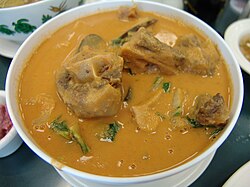Kare-kare
 A bowl of kare-kare | |
| Course | Main course |
|---|---|
| Place of origin | Philippines |
| Serving temperature | Hot |
| Main ingredients | Oxtail, peanut sauce, vegetables |
| Variations | Goat meat kare-kare |
Kare-kare is a Philippine stew (kare derives from "curry") that features a thick savory peanut sauce. It is generally made from a base of stewed oxtail, beef tripe, pork hocks, calves feet, pig's feet or trotters, various cuts of pork, beef stew meat, and occasionally offal. Vegetables, such as include eggplant, Chinese cabbage, or other greens, daikon, green beans, okra, and asparagus beans, are added. The stew is flavored with ground roasted peanuts or peanut butter, onions, and garlic. It is colored with annatto and can be thickened with toasted or plain ground rice.[1][2] Variations of kare-kare can be made with seafood, such as (prawns, squid, and mussels, or exclusively from vegetables.
Condiments and other flavorings are usually added. It is often eaten with bagoong (shrimp paste), sometimes spiced with chili, ginisáng bagoóng (spiced and sautéed shrimp paste), and sprinkled with calamansi juice. Other seasonings are added at the table. Variants may include goat meat or (rarely) chicken.
Traditionally, any Filipino fiesta is not complete without kare-kare.[3]
A more modern twist to the classic Filipino kare-kare uses a different dish as the main meat for this dish. Pork is one of the most economical and easiest meats to cook. The most common meats repurposed for kare-kare are Lechon (which is also used for Lechon Kawali)[4] and Crispy Pata (Crispy Pork Shank.) Alternative main proteins are tofu, beef chuck, beef shank, and Maskara ng Baka or cartilage from the cow’s face, and tripe.[5]
History[]
Kare-kare's storied history as a Filipino food goes back hundreds of years. There are three stories as to the origins of kare-kare. The first one is that it came from Pampanga (the province which became known all over the country as the "culinary capital of the Philippines").[6] The Kapampangan people often have a reputation for cooking to their hearts’ content and coming up with deliciously rich fare. The second comes from the regal dishes of the Moro elite who settled in Manila before the Spanish arrival (in Sulu and Tawi-Tawi, kare-kare remains a popular dish).[7] The third story is from Indian sepoys from Southern India that settled in Philippines during the British occupation of Manila. Homesick, they improvised their own cuisine with available materials. They called it kari-kaari, curry, and now, kare-kare. Its name derived from a reduplication of Tamil: கறி, romanized: kaṟi, lit. 'curry; thick sauce'. Kare-kare has a similar flavor to satay because of the peanuts in the sauce.[8]
Preparation[]

The Oxtail (with the skin on) is cut into 2-inch lengths. The ox tripe is boiled until tender. Sometimes pieces of ox feet or shins are added. When the meat is tender, the soup becomes gelatinous. Ground roasted peanuts (or peanut butter) and ground roasted glutinous rice are added to make the soup thicker. Annatto is added to give color. The vegetables used for kare-kare include young banana flower bud or "heart" (puso ng saging), eggplant, string beans, and Chinese cabbage (pechay).
Kare-kare is often served hot with special bagoong alamang (sauteed salted shrimp paste).
See also[]
- Adobo
- Afritada
- Balbacua
- Dinuguan
- Escabeche
- Kaldereta
- Mechado
- Menudo (stew)
- Sarsiado
- Tinola
- List of peanut dishes
- List of Philippine dishes
- List of stews
References[]
- ^ "Kare-Kare: Filipino ox tail stew".
- ^ "Kare-Kare Recipe".
- ^ "Philippines: Kare Kare". 196 flavors. 2019-01-07. Retrieved 2020-03-05.
- ^ Jun 9, Rachelle Santos |; 2011. "Lechon Kawali Kare-Kare". yummy.ph. Retrieved 2021-08-01.CS1 maint: numeric names: authors list (link)
- ^ "Kare Kare Recipe". Panlasang Pinoy. Retrieved 2021-11-07.
- ^ "Philippines: Kare Kare". 196 flavors. 2019-01-07. Retrieved 2020-03-05.
- ^ Hern, Kathrine Pearl; ez. "Brief History of Kare-kare – Executive Gourmet Catering Services". Retrieved 2020-03-05.
- ^ Villar, Roberto (Aug 2, 2019). "The Fascinating History of Kare-kare". Esquiremag.ph. Retrieved 2020-03-05.
External links[]
 Media related to Kare-kare at Wikimedia Commons
Media related to Kare-kare at Wikimedia Commons
- Philippine stews
- Peanut dishes
